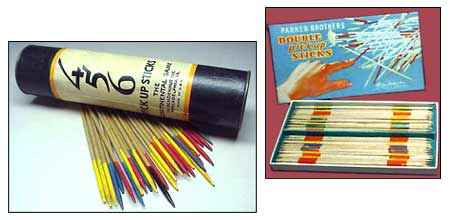Pick Up Sticks

Synopsis of Toy
Long before there was Operation or video games, Pick Up Sticks was helping children around the world develop hand-eye coordination. Easy to learn, but sometimes maddeningly challenging, the deceptively simple game remains popular today for exactly these reasons.
The date when Pick Up Sticks was invented is unclear, but it has been traced back to the Native Americans, who played it with straws of wheat and passed it on to English settlers back when the United States was still known as “the 13 colonies.” As it was passed from generation to generation, it developed into a game that was played with thin wheat-straw shaped pieces of wood. There were usually 25 sticks, and they were either painted with a spectrum of six colors or made from six different shades of wood.
To play Pick Up Sticks, the players would pour the sticks into a jumble on the ground. At this point, the players would take turns trying to remove individual sticks from the pile, one at a time, without disturbing the rest of the sticks in the pile. If a player moved another stick, he forfeited his turn, and the next player would take a shot at it. The process continued until all the sticks were picked up. For variety, some variations of the game included a black stick. If a player picked up this black stick, he could use it during later turns to separate two sticks lying together or to flick one away from another.
Once toys began to be manufactured, Pick Up Sticks became a staple of toy lines because they were easy to manufacture and there were no pesky merchandising rights to deal with. They remain a common sight at toy stores, but are usually made with plastic instead of wood today (for safety reasons, natch). As long as kids need a game of skill to teach them coordination skills, Pick Up Sticks will continue to be one of the reliable staples of the toy kingdom.
Release History of Toy
pre-1900s ?Sub Categories of Toys
gamesother
